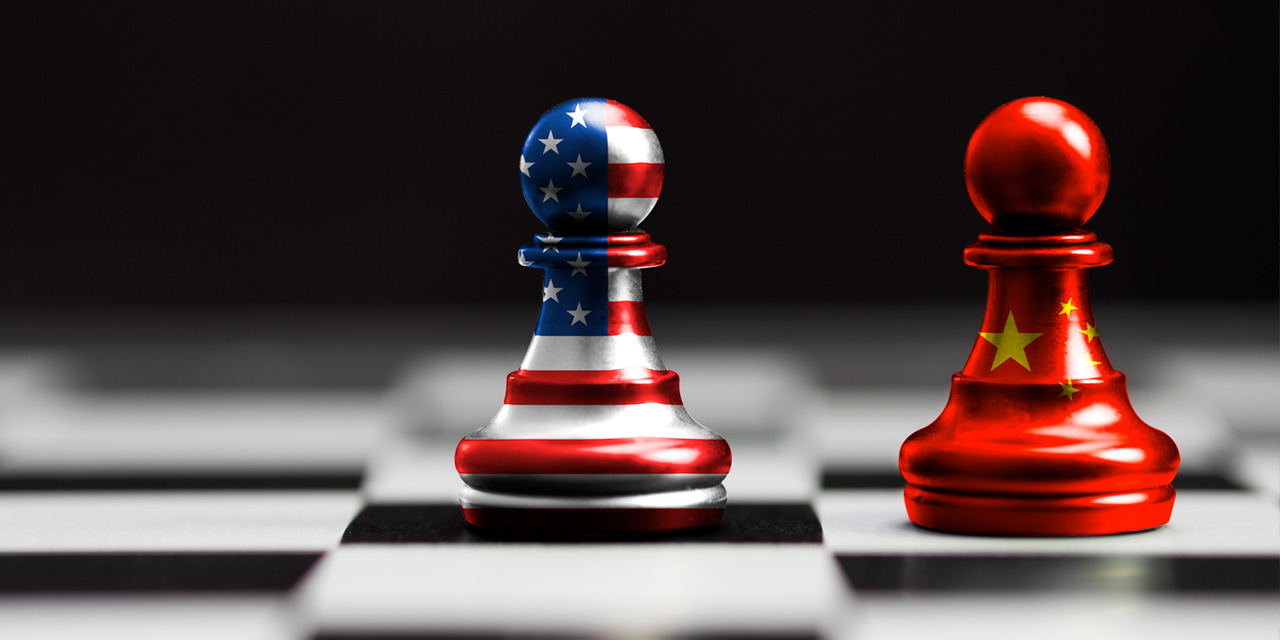Cooperative Security, Arms Control and Disarmament By Ramesh Thakur | 21 October, 2020
A China–US Power Transition, Cold War, or Shooting War?

Image: Dilok Klaisataporn/Shutterstock
How accurate is it to call the current Sino–US hostility Cold War Two? Could it tip the world into a shooting war in which neither emerges victorious and everyone loses?
In an agenda-resetting speech at the Hudson Institute in October 2018, US Vice President Mike Pence outlined a thick catalogue of predatory practices and aggressive behaviour by China. Determined to push the US out of the Western Pacific and stop it from coming to the aid of allies, he said, “Beijing has prioritized capabilities to erode America’s military advantages on land, at sea, in the air, and in space” by constructing an archipelago of military bases on artificial islands and deploying anti-ship and anti-air missiles. But America “will not be intimidated” and will prevail against Chinese malfeasance, Pence concluded.
Walter Russell Mead argued that Pence had launched “Cold War II.” Secretary of State Mike Pompeo updated the administration’s strategic approach to China in a speech in California on 23 July 2020. Depicting China as an existential threat to democracies and declaring that: “Securing our freedoms from the Chinese Communist Party is the mission of our time,” he said “it’s time for a new grouping of like-minded nations, a new alliance of democracies.” Where President Ronald Reagan had based his arms control dealings with the Soviet Union on the bon mot “trust but verify,” Pompeo said, with China’s communist regime, “we must distrust and verify.”
Washington needs to be careful of a self-fulfilling narrative. The rapid deterioration of nuclear arms control, disarmament, and non-proliferation pacts adds to the rising risk of the use of nuclear weapons. Marshall Billingslea, President Donald Trump’s senior envoy on arms control, blithely asserts that: “We know how to win these [arms] races. And we know how to spend the adversary into oblivion.” This is an astonishingly delusional statement in the middle of the coronavirus pandemic and the devastation that the lockdown measures have wreaked on the US economy.
The Cold War 2.0 characterisation is deeply flawed and likely to produce a suite of policies both wrong and dangerous. The Sino–US competition is not a transcendental rivalry in which the two are engaged in a cold fight to the death of each other’s political ideology, economic model and global power aspirations. Neither is ideologically committed to the destruction of the other and intent on winning over as many other countries as possible to its side in the Manichean struggle. The world is not going to divide again into two rigid blocs with virtually no contact between members of the rival blocs. Most countries today have a complex array of interests-based relationships both with China and the US. The US today is not engaged in triumphalist democracy promotion. The crisis of liberal democracy notwithstanding, nor is there any serious competition from China of discredited communism as an alternative organising principle of a political system. China has shown no interest in exporting its economic model either.
The spine of the Cold War ran along the middle of Europe. There is no comparably stark Sino–US geographical front. Unlike rough equivalence between the US and the former Soviet Union in nuclear inventories, China’s 320 nuclear warheads are only 5.5 percent of the US arsenal. Unlike the globe-spanning US–Soviet rivalry, China does not confront the US militarily anywhere outside Asia-Pacific. But unlike the one-dimensional Soviet power, China is a comprehensive national power with a rapidly advancing strategic footprint and growing salience in regional and global governance institutions.
This will sharply reduce the chances of success of any containment policy that ultimately bankrupted the Soviet Union. But it also increases the risks of war arising from a strategic disconnect between China as the emerging superpower and the US as the status quo superpower. The fallacious Cold War analogy feeds a line of thought in Beijing that US enmity has become so implacable that concessions to US demands is pointless. Instead of a new Cold War, what we have is an old-fashioned rivalry and competition between a status quo and a rising power using full-spectrum modern tools of statecraft. Although a shooting war is not inevitable, Graham Allison reminds us of the 75 percent historical probability as per the Thucydides Trap of a military clash during power transitions.
The intensifying China–US conflict will turn to war if, against the psychostrategic backdrop of two centuries of slights, injustices and humiliations inflicted on China by the West and Japan, China’s legitimate aspirations are thwarted and its interests attacked. For China, matters of status and identity trump calculations of economic gain and pain. Americans may believe that the Pacific military balance is so heavily weighted towards the US that Beijing would not be foolish enough to challenge Washington. Or that China’s integration with the regional and international economy makes armed conflict too costly to contemplate.
What if the Chinese leaders believe instead that the costs to Washington would be so high that the US would back down before rising tensions escalate into outright war? The combination of wolf warrior diplomacy and assertive military manoeuvres around China’s land and maritime borders involving many countries has raised questions about the wisdom of President Xi Jinping’s abandonment of paramount leader Deng Xiaoping’s advice for China to be cautious, prudent and bide its time patiently. Has President Xi misjudged China’s moment?
Along many such misperceptions and miscalculations do the bloody rivers of human history flow into the ocean of oblivion for once great powers.
Ramesh Thakur is emeritus professor in the Crawford School of Public Policy, Australian National University; Senior Fellow, Toda Peace Institute; and a member of the Asia-Pacific Leadership Network Board of Directors. He was formerly a United Nations Assistant Secretary-General and Co-Convenor of the APLN.